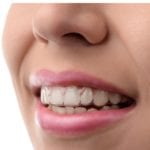For most people, the best teeth straightening options are clear or invisible aligners like Invisalign. Both are options for children or adults, but the current shape of your teeth will impact which option will be best for you.
Clear or invisible aligners are a clear option and involves a series of custom molded aligners that you wear like a retainer over time that helps straighten your teeth. They’re less noticeable than braces and are replaced on average around every two weeks, taking about a year to straighten your teeth.
While there are different factors that impact the price of both of these teeth straightening options, they both have an average cost of around $5,000.
Just like other cosmetic dentistry treatments, orthodontic treatments aren’t cheap.
The most common treatment, metal braces, can range from $3000 – $7000, with an average cost of around $5000.
If you choose non-metal braces, the costs will be higher.
Your location can and will also impact your costs, so consider widening your orthodontist search to run competitive pricing, but understand braces do require 6 to 8 week adjustment appointments in most cases.
Aligner and Brace Treatment Options and Types
Orthodontists have a number of treatment options at their disposal. Some fixed, others removable. But all of them essentially work by placing pressure on the teeth and jaws so that your teeth gradually move into perfect alignment. Below are a few of the more common treatment options that orthodontists use. Which one is best for you depends on the specific issues you’re trying to fix and the severity of the problem.
Invisalign / Clear Aligners
These are becoming more and more popular. They are essentially clear trays that are used to slowly move your teeth into proper alignment. See our article on Invisalign for more details.
Metal braces
Traditional metal braces are what most people think of when it comes to orthodontics. The traditional braces are generally most effective for treating overcrowding than the other options. Once your braces are in place, your orthodontist will make adjustments that will slowly move your teeth into proper alignment.
Ceramic braces
These are similar to metal braces in terms of size and shape, however, their brackets are clear making them less noticeable. The downside is they are more expensive than traditional metal braces.
Lingual braces
These are the same as traditional metal braces, except they go on the inside of your teeth so they are invisible outside your mouth. The cons of lingual braces are they are more expensive, more difficult to clean and more difficult to adjust than normal braces.
Retainers
Retainers are removable devices made of wires or clear plastic. They are mainly used to hold your teeth in place after they’ve already been straightened.








